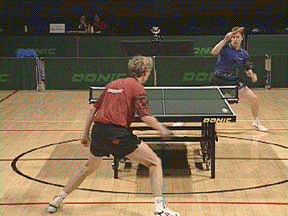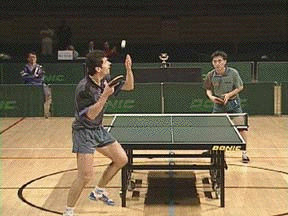
Advanced Skills
1. Looping
This is the most commonly used stroke for every professional table tennis player. To hit a loop, the player must first be in a be in a ready position. This is the position that you must be in between all shots. Keep your knees bent, with your left foot slightly in front of your right (unless you are a lefty). Bend forward a little from your waist and keep both elbows at a 90 degree angle. Try to maintain as much comfort as you can.
Looping is basically finished in a "salute" stance. There are 3 different kinds of forehand loops: a slow loop, a medium loop, and a fast loop. Looping is always a shot done with topspin (see Basic Skills).
The slow loop is usually performed when the opponent hits a shot with a lot of backspin. In this loop, you must have your paddle to your right (or left) side below your knees. Your paddle must be angled at nearly a vertical angle. Let the ball fall down a little bit after it reaches the peak. Now you must drive upwards very hard on the ball, slightly grazing the back-bottom part of it. The slow loop is done in a very long motion, so you must swing very fast. You should hear a low, soft sound when you make contact. Once you reach the salute position, immediately come back to the ready position.
The medium loop is usually done when the opponent hits a "no spin" ball or one with a little bit of backspin or topspin. From the ready position, have your paddle to your side slightly above knee level at a closed, 45 degree angle. Drive upwards and slightly forward on the ball, hitting it on the back-top part.. Finish in the same salute position and change to the ready position quickly. The sound you hear should be louder and higher than a slow loop, because you are making more direct contact with the ball.
The fast loop is done strictly against other fast loops (fast topspin shots). You have very little time to do this motion, so it's very important that you are in the ready position to receive the shot. When you realize what shot the opponent has hit (which should be a split-split second), quickly move you paddle to you side and at waist level. The paddle angle should be less than 40 degrees. Now with a strong up-forward motion, hit the top part of the coming ball at it's peak. Since this shot requires the ball to be hit hard, make sure that the sound you hear is loud and high.

The man facing the camera is hitting a forehand fast loop.
The backhand loop can also be hit as a slow, medium, or fast loop. The principles are the same as the forehand: start low, finish high. In fact, the only change in the backhand loop is that instead of hitting the ball to your side, hit it directly in front of you. You should almost always start by holding the paddle between your legs, slightly below your hips. The paddle angles for each type of loop are the same as in the forehand loop.
2. Other Strokes
The wrist flick is almost always done from the backhand side. It is usually done to return a serve or to return a ball hit very short and low by the opponent. For this stroke, there is no backswing. All you must do is extend your arm so the paddle is nearly touching the ball, and flick your wrist over it. This important because it must be hit with topspin in order to decrease your opponent's chances of smashing the ball and ending the point.
The counter is used against topspin balls which you have no time to loop. This stroke requires very little forward arm motion, but it is extremely important that you angle and position your paddle correctly. If it is hard topspin, you must angle your paddle downward, so the ball is forced not to pop up when you hit it. If it is soft topspin, do angle your paddle so it's nearly facing the opponent. On this shot, unlike many others, the backhand is perfomed almost the same way as the forehand, except that you try to hit the backhand in front of you. If hitting either a backhand or a forehand, the paddle should only move forward about a foot during the complete shot. Like always, quickly return to the ready position.
The block is used against lightly backspun balls. The arm motion is the same as the counter, but in this stroke, you must hit under the ball, angle your paddle 55 degrees upwards. Blocking is used on all balls except ones hit deep onto your side and/or with lots of backspin.
The chop is a longer version of the block, with your paddle angled at about 65 degrees upward, depending on how much backspin is on the ball. For a backhand chop, start with your paddle nearly touching your bicep or shoulder. Hit the ball when it comes within a foot of your body. Swing harder and longer than you would hitting a counter, making sure you put a considerable amount of backspin on the ball. Finish with your paddle directly in front of you. From the forehand side, start with your paddle at the same place but on the opposite side. Use the exact same motion as the backhand chop, also finishing with the paddle directly in front of you.
The serve is the most complicated and important shot in the game. It is your choice which kind of serve you want to use, forehand or backhand, long or short, backspin, sidespin, or topspin. All that can be said is you must start with the ball above the table in a flat palm. The ball must be tossed upwards at least six inches, and must be hit while falling downwards. With all the knowledge you already kow about spins, experiment with all the different serves. Whan playing an opponent, find his weakness and keep serving him that serve. Many points are won off good serves.

The man in this picture is about to hit a forehand backspin serve.
The smash is considered a "put-away" shot. Used aginst balls hit high in the air, angle your paddle slightly downward and with a long forward motion, hitting the ball as hard as you can while still getting it to bounce on your opponent's side. This shot overall wins the most points in table tennis.
Movies (in QT movie format)
Click here to download a 1 MB movie showing two players looping and blocking (Jorgen Persson vs. Zoran Primorac). The sequence is as follows: (1) Persson- Forehand backspin serve (2) Primorac- Bachand wrist flick (3) Persson- Backhand counter (4) Primorac- Forehand medium loop (5) Persson- Forehand fast loop (6) Primorac- Backhand counter (7) Persson- Backhand "Swat Kill."
Click here to see a 1.8 MB movie showing a long loop-and-block rally between Jan-Ove Waldner (blue) and Johnny Huang (yellow). Johnny Huang starts with a backhand serve and is "on the offensive" throughout the point.